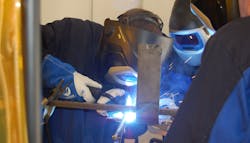Ken Risdon is like many shop owners in the collision repair market. He comes from a collision repair bloodline, having both a grandfather, father and one uncle who worked and owned repair businesses. After working as a painter and technician for a decade before moving into another occupation (as a financial advisor), he returned last year to take over the family shop when his father decided to retire early. Now the owner of the newly named K Risdon Bodyworks in Columbus, Ohio, he found early success as an owner before COVID restrictions slowed business for two years, then came roaring back as the economy opened. Now, while hoping to expand, he’s facing the same labor crunch as the rest of the industry and most of the nation.
“I need people pretty much everywhere,” he says. “I’d like to add a tech, at least two painters, and one estimator, but I can’t find anyone. We’re surviving, but I’m watching a lot of business bypass my doors.”
Realizing that he couldn’t wait for the employment market to provide solutions, Risdon came up with his own. Like some of you, he decided to build his own labor pool with a mentoring program. A lot of shops had success here, so why couldn’t he?
Risdon said creating such a program was far easier said than done, but the lessons he’s learned could help you.
Refer to the following five points on building a mentoring program supplied by Risdon and other experts in the collision repair industry.
Point 1: Don’t lock yourself into thinking mentoring/apprenticeship programs are all the same
Nowhere in your business thinking should you ever limit either your understanding of a concept or hold onto preconceptions. If you’ve decided your program must follow a specific model, you should change your thinking (although there are organizations in the collision industry that do support some specific, very successful models). Risdon looked at several and talked to some of his colleagues with training programs and decided he would need to build a program specific to his operation. In particular, he would need one that could target training prospects in his region and prepare them to work in his shop’s culture.
“We didn’t have any tech colleges or high schools nearby that we could work with right away,” he explains. “That left us with going to temp services and hiring firms that would help us market what we wanted to do. We had to rethink exactly what our program would be, what our expectations were, and the kinds of folks we wanted to target.”
Risdon, like other repairers, had to wrestle with the differences between a mentoring and an apprenticeship program. Strictly speaking, in an apprenticeship, an expert passes on skills, and you learn to be an apprentice in the workplace. In a mentoring program, an experienced worker mentors (works with and educates) a less experienced worker to build skills and foster professional growth. In short, a classic mentorship involves introducing an inexperienced person to skills and an understanding of the workplace while an apprenticeship is focused on building technical skills and business acumen for the apprentice to carry into the training workplace.
Some shops operate mentoring programs aimed at giving young tech school students a taste of the workplace, with the goal of having them return when they’ve completed formal technical training. Others prefer apprenticeship programs that allow them to train their own employees, allowing them to build careers from the bottom up. Some shops incorporate aspects of both in a single program or carry two distinct programs.
Barry Dorn, owner of Dorn’s Body and Paint in Mechanicsville, Virginia, has used an apprentice program for more than 10 years. Instead of hiring from the outside, Dorn’s creates its own labor pool and draws employees exclusively from it.
“We found that when you bring in employees who have worked in other shops, too often they bring habits we don’t want with them,” says Dorn.
In his program, apprentices are paired with a number of different techs across the business to learn every aspect of repair. The shop also trains its estimators and painters through the same program.
Ron Reichen, President of Precision Body and Paint in Beaverton, Oregon, uses a similar approach for one of his training programs, which he describes as a “three-headed monster":
- The aforesaid traditional apprenticeship model.
- Work with Skills USA and local schools to bring help into the business.
- The third is conducted in a local penitentiary.
Former prisoners (yes, prisoners!) can be a great source of training candidates. Reichen’s staff works with carefully vetted prisoners — whose terms will end in two years — who enter into a vehicle repair program at a reformatory. He says people looking for opportunities to turn their lives around and work can end up being some of your best employees.
He’s attached this kind of “outside the box” thinking to what could be considered another training program at his business, reaching out to workers from other industries with transferable job skills and teaching them to work in collision repair. This philosophy runs into Point 2.
Point 2: Consider program candidates with limited industry experience
Reichen reports considerable success identifying training candidates outside the industry. For example, he recently hired a retiree who works at a nearby YMCA to do marketing for his shop.
“The guy told me he had never worked around cars, but I told him that doesn’t matter,” explains Reichen. “I have him use his social and public relation skills to promote us at Chamber of Commerce Functions and elsewhere.”
Reichen also says the industry needs to open itself up to an increase in female workers, as it dispenses with worn-out notions of who a collision repairer is.
Dorn adopts a similar take, as his business prefers to find apprentices who haven’t spent significant time working anywhere in the industry but who have a dedicated interest in repairing vehicles. He says one exception to this approach is an apprentice who had worked in collision repairs for two years before moving on to factory work. From there, his interest in repairs was reignited. The two years of previous work wasn’t a deal breaker, explains Dorn, because the apprentice was still learning to perform repairs and had a passion for the work.
That level of interest is a key indicator of success in an apprenticeship program. Dorn says one of the most important traits his business looks for in apprentices is an “investment in themselves and the business.” Risdon says character and passion matter first.
“You can teach skills but not passion," Risdon noted. "Your employees have to bring that with them. That’s what they need to bring to the table, far more than any kind of vehicle experience. Look past your old notions of what a repair staff should be and harness the energy of those looking for a chance to perform and work hard for you and themselves."
Point 3: Not everyone will complete your program
The only firm guarantee that comes with any mentoring or apprentice program is your promise to carry through with your part of the program. Many, and in some cases, most of the people entering a training program will not complete it. Dorn reports that only about a third of his last group of apprentices completed his program and stayed on at his business.
Risdon has seen the same rate in his young program. He says shops shouldn’t be dissuaded by what may appear to be failure.
“We’ve found that most of the people who didn’t make it realized they didn’t have the passionate interest in being repairers that they would need to succeed,” Risdon says. “It’s best for both parties they move on since neither of us are going to be happy, and we’re just delaying them leaving later down the road. I’ll take a people success rate of 25 or 30 percent every time because I still end up with a great employee. These days and in this climate, you can't even put a price on adding a good worker you can trust. They're priceless."
Point 4: Base the training time on the person.
How long should it take for a candidate to complete your mentoring/apprenticeship program? That will depend upon a number of factors:
- Goals of the program.
- Weekly hours the candidate commits to.
- The availability of the people doing the training.
- Dorn says in his program, the ability of the apprentice to work on his or her own is the ultimate decider.
“The average time it takes to complete the program is about eight months, but we have people who will take well over a year,” he says. “Sometimes we’ll have someone who is particularly sharp who can do it in less time. It all comes down to what that person shows he can do.”
Risdon seconds this notion. He says that as his business develops its training program, applying a “one-size-fits-all” mentality just doesn’t work.
“You want to set deadlines, but it’s difficult since the different tasks you want to teach are based on the work that comes in,” he explains. “As an example, you can’t teach some structural work on certain car models until that work hits your doors.”
Also, he says people don’t learn and acquire confidence in their abilities at the same rate. He notes that even early on in his program’s development, he’s noticed that the candidates his staff believe have the most potential sometimes take longer to complete the program.
“They want to make sure they’re doing everything correctly, so they ask for additional time to gain experience on some repairs, and that’s fine," he states. "Being self-aware enough to know your limits is a really good quality to bring to the job.
Point 5: Make these programs a permanent part of your future.
Reichen cites some important numbers when discussing mentoring/apprentice programs and other training in the collision industry.
“When I graduated high school in 1971, 44 percent of graduates needed to go to a four-year college or university to prepare for a job. Today that number is 27 percent, so you can see that 73 percent now need to go into a skilled profession or a trade,” he says.
Unfortunately, much of the United States education system is still focused on preparing as many students as possible for college when jobs are elsewhere. Reichen believes the collision industry needs to reach out to these students, going back as far as middle school, to help drive interest and create career paths in auto body repair. This means that your input is needed now and in the foreseeable future to build the employment pool you and the rest of the industry relies upon.
In other words, a mentoring/apprenticeship program isn’t a short-term solution. It’s not something your shop is going to build now and then toss itself when the employment market rights itself, if it ever does. Ultimately, Risdon says that might be a good thing.
“Shops aren’t going to invest a lot of money into an expensive piece of equipment they might not need in a few years, but it turns out to be something you use every day, it’s a great purchase,” he explains. “It’s the same way with training. An apprenticeship costs plenty in terms of time and money, but when that person comes to work for you, and you don’t have to go begging for help, it pays for itself every single day.”
He goes on, “People are always your best investment, and that investment should never end.”




